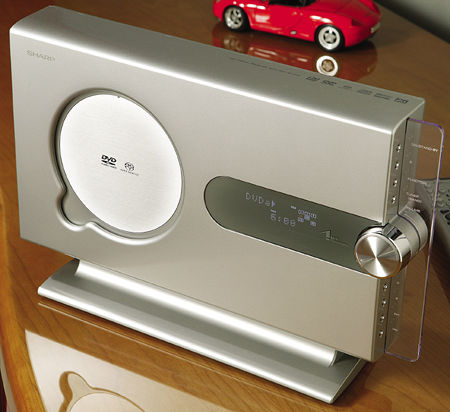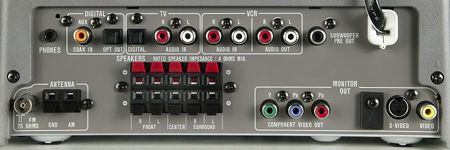Sharp SD-PX2 DVD/Receiver
In a previous lifetime, the Sharp SD-PX2 was probably a too-cool 1940s Bakelite radio—boxy, plastic, and proud of it. The SD-PX2 DVD/receiver is a certifiable forward-thinker. Utilizing Sharp's 1-Bit digital amplifier technology, the streamline SD-PX2 packs a DVD player and receiver into a stand-up chassis that, at only 4.5 inches deep, wouldn't look out of place on a bedside stand.

Of course, modern marvel that it is, the SD-PX2 would rather hang (it comes with a wall-mounting bracket) next to an LCD or plasma display. At $599, however, this HTIB without the speakers should not be typecast. It's a space-saving building block for a budget system for a small room or apartment.
How does Sharp get a five-pack of 25-watt amplifiers, a progressive-scan universal disc player, Dolby Digital and DTS decoders, an AM/FM tuner, and even a clock in a package that is fewer than
15 inches wide and 10 high? It's all in the numbers, as in digital. This unit's 1-Bit digital amplifier radiates 80 percent less heat, consumes about half the power, and is one-third the size of a conventional analog amplifier.
It works in a way similar to how an SACD reproduces sound, creating a digital snapshot of the analog original with 2,822,400 samples per second (2.8 megahertz) in 1-bit chunks. In the same time it takes a CD to take one 16-bit sample and DVD-Audio four 24-bit samples, the 1-Bit technology has sampled the same sound segment 64 times using a seventh-order delta-sigma analog-to-digital converter.
The best thing about the SD-PX2: It's not an HTIB. With too few exceptions, in a packaged system, speakers are often substandard throw-ins. With the SD-PX2, you pick your own. Just make sure they're reasonably efficient. The SD-PX2's low power output requires careful matching in terms of speakers and room size. Properly set up, the SD-PX2 offers smooth, easy sound that defies its power rating and exceptionally high distortion specification. I used it mostly with a PSB Alpha B system that included the Alpha SubSonic 5 subwoofer, about $1,200 worth of speakers. Paired with the Athena Micra 6 speaker system ($550), the SD-PX2 would challenge any $1,000 HTIB on the market.
The Silver Shakedown
The SD-PX2's faux-aluminum finish is so convincing that it takes a couple of taps to realize that, alas, it's Grade A plastic. It's an extremely attractive unit, distinctive for its upright design, vertically mounted DVD drawer with an automatic sliding door, and Plexiglas side panel illuminated by a blue LED. From the front, you'll see only the DVD mechanism and rectangular display screen that bleeds into a large, rotary volume control to the far right. A stack of tiny push-button controls abuts the Plexiglas panel.
This is a love-at-first-sight kind of machine. It's cool, compact, and incorporates of-the-moment technology like 1-Bit, SACD, and DVD-Audio. It's also underpowered, with limited connections, low-quality speaker terminals, average video quality, and, on the audio side, a weak lower-midrange region. However, the flaws are no worse than those of many other DVD/receivers and HTIB systems.
The SD-PX2's speaker terminals are about as bad as it gets. Tiny spring clips are jammed so close together that short-circuiting the speaker connection by crossing exposed wires becomes a real danger. I should know, as it happened twice while I calibrated the system. If the SD-PX2 were staying in my home permanently, I'd re-cut the speaker wire to expose only enough to insert into the terminals, leaving the rest protected by the wire's plastic sheath.

Otherwise, the SD-PX2 was easy to set up using the onscreen menu, although the test-tone signals for speaker calibration were so short, maybe two seconds each, that I had to use a test disc to ensure accuracy. I was particularly impressed that the delay and bass-management settings applied to both SACD and DVD-Audio discs (that's not always the case). There was one exception: For DVD-Audio, the crossover frequency reverts to the default 80 hertz. It didn't matter with the PSB Alphas, nor will it matter with most bookshelf or bigger speakers because 80 Hz is often the preferred setting.
With 1-Bit technology, the signal goes round and round before reaching the speakers. Let's take a ride with DVD-Audio: The SD-PX2 converts the digital signal to analog before sending it to the 1-Bit amplifier circuit, where it's converted back to a digital signal that's sent to the amplifier. The amplifier sends 2.8-MHz pulses through a low-pass filter to the speaker terminals. Sharp says that the speakers actually perform final digital-to-analog conversion.
The SD-PX2's rated distortion figures—2 percent total harmonic from 120 Hz to 20 kilohertz into a 4-ohm load—are high by solid-state standards but in line with audiophile vacuum-tube gear. A good audio receiver's distortion rating will generally be less than 0.1 percent. Sharp notes that the 1-Bit technology's exceptionally high speed is too fast for the low-pass filter on the front end of most test equipment, resulting in misleading readings, but our audio technical editor scowled when he heard that explanation. Let me put you at ease about the SD-PX2 and distortion: If this is what 2 percent distortion sounds like with a digital amplifier, you can live with it.
The vertical-mounted DVD mechanism scores heavy design points, but I never mastered removing the disc in one shot; there isn't enough finger room. The vertical design also exposes the laser-pickup lens, which makes it vulnerable to fingerprint smudges. I much prefer a top-loading mechanism that automatically ejects the disc.
Just wait until your neighbors find out that you can perform gamma correction (changing the picture's brightness curve) using the surprisingly thorough remote control. The SD-PX2 also features other tricks, like a Dim Auto setting that dims the display and shuts down the blue LED five seconds after a DVD starts playing.
Mighty Mite
As the SD-PX2 warmed up for several days in stereo mode with my B&W DM303 bookshelf speakers, it was hard not to be drawn into its warm, soothing sound. Once connected and set up in a home theater using the onscreen menu, the SD-PX2 faced an instant stress test with a special-effects chestnut: the "Time's Up" sequence from the Superbit edition of Independence Day. Not only did the SD-PX2 survive the conflagration, but it hit 90 decibels handily on an SPL meter and scared Chesty Morgan, my cat, right out of the small room. That's some big bang for an 8-pound, 25-watt DVD/receiver.
The SD-PX2 also did justice to a great soundtrack from a more up-to-date demo favorite, The Return of the King. The screeching from a pack of attacking dragons ridden by the Nazgl came from all angles. It was as powerful and dynamic as any HTIB I've heard.
 The SD-PX2 scaled another Superbit title, Spider-Man, as Peter Parker tests his newfound powers in the "Scaling the Heights" scene. It negotiated all of the sonic effects, although for the first time I noticed a slight dropout in the Alpha B satellites' lower frequencies.
The SD-PX2 scaled another Superbit title, Spider-Man, as Peter Parker tests his newfound powers in the "Scaling the Heights" scene. It negotiated all of the sonic effects, although for the first time I noticed a slight dropout in the Alpha B satellites' lower frequencies.
That dropout became even more noticeable with music, particularly female vocals. Eliza Carthy and Nancy Kerr sounded breathy, with sibilance, on the a cappella "Bushes & Briars" from On Reflection. The soundstage on Gillian Welch's "Red Clay Halo" from Time (The Revelator) didn't extend too far beyond the speakers, and her voice was also missing something in the lower midrange.
The same was true in high-resolution mode, where everything except Jane Monheit's voice on "Blame It on My Youth" from the Come Dream with Me DVD-Audio sounded on target. Patricia Barber's lowdown vocals didn't go down quite low enough on "Beat Goes On" from the Mobile Fidelity SACD reissue of Companion.
I'll take a relaxed lower midrange any day over the grating high frequencies of HTIB-style systems. Those graduating from a $200 minisystem to the SD-PX2 probably won't notice it. More likely, they'll be bowled over by the high-resolution qualities of SACD and DVD-Audio.
Although the SD-PX2 deserves a must-audition rating, especially for the HTIB shopper, Sharp's engineers no doubt will continue to fine-tune the new 1-Bit technology. It's got most of the budget class beat already, and it'll only get better, smaller, and more powerful.
Highlights
• Cool, compact 1-Bit amplification
• Easy-on-the-ears sound
• Easy-on-the-eyes design





























































